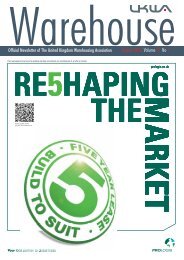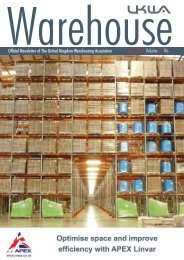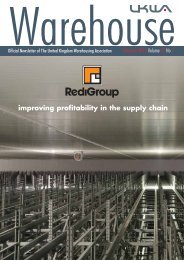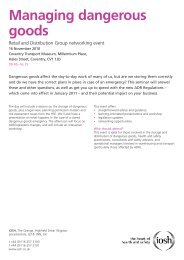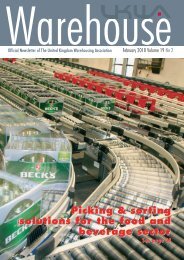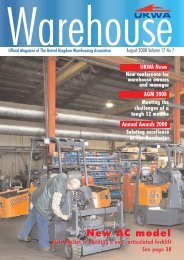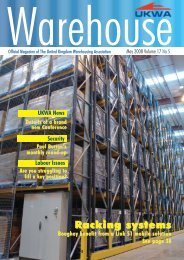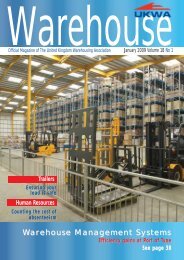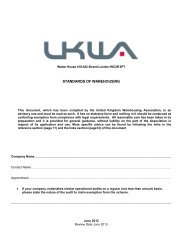ifwla - Warehousing and Logistics International
ifwla - Warehousing and Logistics International
ifwla - Warehousing and Logistics International
- No tags were found...
Create successful ePaper yourself
Turn your PDF publications into a flip-book with our unique Google optimized e-Paper software.
38 North Americawage costs were comparable to China of the early2000s.• China selling more of its production to domestic <strong>and</strong>intraregional markets.• Near sourcing from Mexico grows at rates comparableto growth of Maquiladoras in early NAFTA years.• The Total L<strong>and</strong>ed Cost of products from Mexico islower than Total L<strong>and</strong>ed Costs of sourcing from Chinafor many products, a reversal of the situation throughoutthe period 2000 to 2006.• The change in comparative costs for serving N.A.markets is due to:• Continued wage increases in China relative towages in Mexico • Strength of the RMB versus weaknessof peso • Higher transportation costs due to fuelcosts eroding low cost manufacturing advantage ofAsia • Mexico’s National Infrastructure Program is 50% complete, reducing transportation costs to moveproducts from inside Mexico to U.S.• Mexico is also preferred for its proximity to the U.S.market as more firms adopt dem<strong>and</strong> driven supplychain strategies.• West coast gateways start to lose traffic to Panamarouted traffic as new canal capacity opened in 2015(one year late) <strong>and</strong> multiple rail corridors from eastcoast ports come on line. Growth rate of Panama routedtraffic higher than west coast intermodal traffic tocentral <strong>and</strong> south central markets. LA/LB most affected.• In addition, more products are starting to be manufacturedin South Asia making transport direct to theEast Coast of N.A. via the Suez more competitive.• PMV maintains its share of a slower growing trafficbase from North Asia to central <strong>and</strong> south central U.S.2031 – 2045• China begins to lose its overall low cost country leadershipin Asia to India <strong>and</strong> other South Asia countries.• Exports to North America are increasingly routedthrough the Suez to the East Coast from India <strong>and</strong> viathe Panama to the East <strong>and</strong> Gulf Coast ports fromSouth Asia.• Mexico, other Latin American <strong>and</strong> South Americancountries have established Total L<strong>and</strong>ed Cost advantagefor many products <strong>and</strong> export growth to U.S. issimilar to China’s export growth in early 2000s.• Asian import traffic to central <strong>and</strong> south central U.S.markets via West coast entry grows slowly but grows ata higher rate via east coast <strong>and</strong> gulf port gateways.• U.S. railroads <strong>and</strong> ports finally forge cooperativeagreements modeled after those between the ports <strong>and</strong>railroads in Canada, reducing competitive advantageof cooperation held by PMV for decade.• <strong>Logistics</strong> value added services grow as theVancouver gateway import DCs start locating in lowermainl<strong>and</strong> to distribute to Western half of NorthAmerica.• Climate change favors growth in Plains <strong>and</strong> RockyMountain regions of U.S as well as Prairie Provinces inCanada. Shift in economic growth to these areasincreasing dem<strong>and</strong> for imports to these regions. Tosmall degree offsets decline in Asian imports to east viaWest coast.• New APGC program emphasizes intermodal <strong>and</strong>road development to provide access to Western markets.Western regional highway network starts to developalong with regional distribution networks.• PMV traffic growth levels off in low single digits inlast five years of period.2045 <strong>and</strong> beyond• Growth in Asian exports to N.A. has leveled off toreflect growth of world economies rather than growthin market share.• Share of intermodal traffic to eastern U.S. via WestCoast intermodal has declined but stabilized.• However due to l<strong>and</strong> use constraints <strong>and</strong> significantenvironmental limits, LA/LB has been forced to pursuea zero growth policy for the foreseeable future. Thishas in turn diverted west coast intermodal traffic to thePNW ports as well as to Larzaro Cardenas <strong>and</strong> thePanama routing.• U.S. gateway <strong>and</strong> corridor competition has caught upwith the APGC in terms of transport coordination betweentransport providers making service to eastern <strong>and</strong> centralU.S. via U.S. gateways such as Seattle Tacoma comparableif not superior to service via the APGC.• Growth in regional distribution justifies ProLogisestablishment of Distribution Facilities in LowerMainl<strong>and</strong> (don’t quote me!)• PMV <strong>and</strong> APGC reinvent itself. PMV seeks to maintainits existing competitive position in long haul Westcoast intermodal traffic market, particularly in Canada,however growth is developed through movement ofimported products through a rail – road network servingthe northwest half of the U.S. <strong>and</strong> the western <strong>and</strong>prairie province.• Key to this strategy is a new treaty guaranteeing free<strong>and</strong> unfettered movement across the Canada – U.S.border (we need to work on it now!).Many of the assumptions stated in these scenariosare real <strong>and</strong> occurring at this moment. Others are real<strong>and</strong> it is not an issue of whether they will happen butwhen. Some are wishful thinking on one h<strong>and</strong> butcould be a reality if stakeholders in PMV are up to thetask. Some may change in timing or direction <strong>and</strong> ofcourse the quantitative magnitude of change is notmeasured with any precision.Garl<strong>and</strong> Chow is the Associate Professor <strong>and</strong> Director,Bureau of Intelligent Transportation Systems <strong>and</strong> FreightSecurity, Sauder School of Business, University of BritishColumbia.Issue No. 3www.warehousinglogisticsinternational.com




